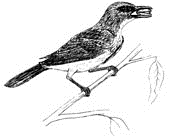Vertebrate Pest Conference: Proceedings

Vertebrate Pest Conference Proceedings: 17th (1996)
Date of this Version
1996
Document Type
Article
Citation
Published in Proceedings: Seventeenth Vertebrate Pest Conference … 1996, ed. Robert M. Timm & A. Charles Crabb (University of California, Davis, 1996).
Abstract
Few effective repellents are currently available for the non-lethal management of vertebrate pests. This is perhaps not surprising considering the ad hoc nature of past applications which assumed that the target pest species would have the same attraction/aversion preferences as man. A more rational approach is to identify compounds that have real biological significance for the pest species. Plants have evolved an array of defense chemicals (secondary plant compounds) that inhibit the feeding of vertebrate herbivores, because they are either innately aversive or they generate a conditioned aversion. These compounds are, therefore, ideally suited for use in the reduction of feeding damage to crops, forest plantations and stored food products. Several of these novel plant-derived materials (e.g., cinnamamide) are already undergoing commercial evaluation. This approach facilitates the use of a number of systems to increase a plant's resistance to attack: topical application of the defense compound, systemic stimulation of the plants own resistance mechanisms and genetic enhancement. The two latter systems will enable the utilization of potent repellents that are not commercially viable for topical application and to concentrate their expression in the most palatable and vulnerable tissues. This paper also discusses work undertaken to improve our knowledge of the feeding strategies of target species. A proper understanding of these behaviors is essential before it will finally be possible to predict the field conditions under which a repellent will be effective.
Included in
Animal Sciences Commons, Bioresource and Agricultural Engineering Commons, Environmental Engineering Commons


Comments
Copyright © 1996 (where applicable) by the Vertebrate Pest Council of the Vertebrate Pest Conference. Used by permission.